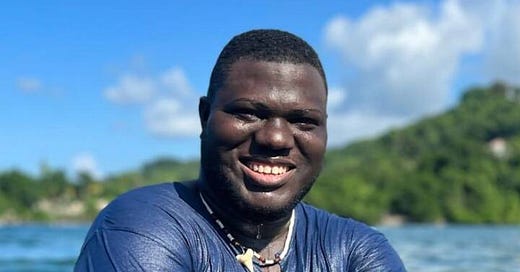🌊Developing Jamaica’s Blue Economy with Kee Farms
PLUS Biden announces roadmap for Nature-Based Solutions & Biotic raises €2m.
"Read as much as possible, quickly form your own opinions about the space, and try to have fun…" — Dean Morris, COO of Kee Farms
Dear algae technologists - hello and welcome to the Paxtier Report!
To start this email, here’s a little highlight from my recent call with Cascadia Seaweed’s Rob Napoli:

In today’s report:
Markets: 💸 Biden-Harris Administration Announces Roadmap for Nature-Based Solutions
Deals: 🤝 Biotic raises €2m seed round to commodify biodegradable plastic materials.
Movers and Shakers: 🌍 Developing Jamaica’s Blue Economy with Kee Farms.
Around the web: 💡 Are carbon regulations holding back early adopters?
Research Rundown: 📝 Capturing carbon using photosynthetic biocomposites
Markets and Investing
✂️Algae Market Snippets
Some big moves in recent weeks:
Volta Greentech have partnered up with several Swedish food companies and have received a €2m strategic investment to accelerate their mission to reduce methane emissions from cows. (Read more HERE).
Stefano Bernardi launches new fund - Unruly Capital. And he’s been looking at algae tech (Read more HERE).
Bright Tide launch new Blue Carbon Accelerator Programme (Read more HERE).
ULUU complete $5.3 million USD funding round 👏🌿. "The Australian start-up uses seaweed to create a plastic alternative and is planning to launch its first products in the next 12 to 24 months." (Read more HERE).
Seaweed snack brand SHORE has successfully secured a six-figure investment. 🏖️ It will use the capital to "progress production of its seaweed harvesting as well as expanding and creating new ranges of products."(Read more HERE).
IKEA Foundation to deploy €600m on philanthropic climate solutions by 2025 👏👏Areas of investment focus will include: "delivering an inclusive energy transition, minimising methane emissions, and shifting to plant-based protein. (Read more HERE).
Biotic raises €2m seed round to commodify biodegradable plastic materials. (Read more HERE).
Azores Life Science has secured 500,000-euros to further develop algal personal care products. 👏👏 The capital will be used to explore the role of microalgae and macroalgae in skincare, haircare and wellness applications. 💄 (Read more HERE).
Energy Impact Partners’ Frontier Fund Closes Oversubscribed at $485 Million (Read more HERE).
The Port of San Diego is adding five years onto its agreement with Sunken Seaweed LLC, a local start-up exploring the feasibility and benefits of seaweed and shellfish farming in San Diego Bay. The port is also investing $100,000 into the project in exchange for an increase in revenue share from 5 percent to 6 percent and an extended revenue share period from 2043 to 2048.(Read more HERE).
Merck is bringing RonaCare® JouvaMer, and RonaCare® ReviMer to Asia. These two products have been developed from brown seaweed endemic to the Breton coast in France. (Read more HERE).
The first community owned processing facility for seaweed in Scotland is coming. (Read more HERE).
Finland’s University of Turku has received over 900 000 euros to establish a large algae production plant. (Read more HERE).
Three product launches from FrieslandCampina Ingredients enable higher LCPUFA concentrations (Read more HERE).
Denmark’s Sundew ApS, an algae biotech firm, has entered a multi-year collaboration with the United States to help combat aquatic invasive species using its algal RNA-mediated interface. (Read more HERE).
Canada’s Konscious Foods, Merit Functional Foods and Canadian Pacifico Seaweeds announce a new partnership to develop an extensive line of plant-based seafood alternatives. And $15.3M has been invested. (Read more HERE).
SMC & AltaSea developing program to create Blue Economy (Read more HERE).
CJ Cheiljedang, Korea’s number one food company, has appointed Art of the Possible as its strategic and creative agency for bibigo seaweed snacks, as it prepares to launch the brand across Europe. (Read more HERE).
ONCRA Launches at COP27: Carbon removal credits for natural climate innovation (Read more HERE).
A $700,000 loan for aquaculture research in the Bay of Plenty will create six new marine sector jobs. (Read more HERE).
Biden-Harris Administration Announces Roadmap for Nature-Based Solutions to Fight Climate Change, Strengthen Communities, and Support Local Economies (Read more HERE).
WEF, Indonesia Launch New Initiative to Support a Sustainable Ocean Economy (Read more HERE).
In depth with Peter Green
🌍Developing Jamaica’s Blue Economy with Kee Farms
Dean Morris is the Co-founder and COO of Kee Farms, a seaweed start-up exploring carbon removal and ocean habitat restoration in the Caribbean.
Dean believes that macroalgae cultivation can make a significant difference to Jamaica's Blue Economy.
And in this snippet from our recent call, Dean and I discuss the evolution of the organisation, major challenges for the industry, and advice for others in the space.
How has Kee Farms evolved to where it is now?
In a nutshell, Kee Farms was created to help fisherfolk in Jamaica. We believed that seaweed aquaculture could significantly improve the lives of these ocean-faring people. So, we developed several courses to inform them about macroalgae farming. And we now hope to support this network of seaweed farmers with operations, customer acquisition and scaling.
In addition, we're currently halfway through our seaweed farming pilot project, which has been supported by several environmental bodies and the Jamaican government. And we’ve also been developing a guidebook which will explain to fisherfolk and marine sanctuaries how to cultivate sustainably in the region.
What major challenges are you encountering?
Obviously, there’s plenty of academic work in this space. But there’s less info out there about Gracilaria, our main genus of interest. This means we spend a lot of time repurposing technical knowledge about other species, developing methodologies from scratch, and searching for people to explain things to us - which isn’t super efficient. Overall, to resolve all of this, I’d generally like to see more information localised in one online space.
Then there’s the arsenic problem. This challenge arises every year as Jamaica deals with massive blooms of Sargassum seaweed. Essentially, it's not simple to deal with this biomass because it’s chock-full of arsenic. But we’re figuring out ways to address this at Kee Farms.
What advice would you give to someone else starting on this journey?
Firstly, learn to swim. Then, read as much as possible, quickly form your own opinions about the space, and try to have fun.
If you’d like to learn more about Kee Farms or join them in their mission, check out the company on Twitter, Facebook, and LinkedIn. You can also follow Dean on Twitter here.
🐦Tweet of the week
📝Research Rundown: Capturing carbon using photosynthetic biocomposites
THE BIG IDEA
To meet impending Paris Agreement targets, carbon capture and storage is a necessity.
This has encouraged teams all over the world to develop novel sequestration technologies, from BECCS to enhanced weathering.
And last week, In-na et al. took novelty to a whole new level, by proposing a route to carbon capture using genetically engineered cyanobacterial biocomposites.
The breakdown
These biocomposites were made by immobilising cyanobacterial populations as thin biocoatings on a polymer matrix (see figure).
The tech was modelled on Lichens - organisms which consist of a fungus (which provides physical support, protection and anchorage) and a photobiont, which supplies carbon to the fungus.
And after measuring the photophysiology of the polymers, the team were pretty impressed with the results…
The results
In-na et al. discovered that these biocomposites could efficiently absorb CO₂ over months-long operational periods with minimal cell loss…
… And could capture up to 570 tCO₂ t⁻¹ biomass yr⁻¹, delivering annualised CO₂ removal of 8–12 GtCO₂ - which, in theory, could be leveraged to develop a plethora of new carbon sequestration devices.
So, when reading, be sure to check out…
The proposals for further optimisation. For example, by genetically engineering the lichen mimics we could significantly enhance carbon capture and resilience properties - offering increased CO₂ removal with low water, nutrient, and land use penalties.
🔥 What else was hot in algae tech?
Interesting reports by EDF weigh-up seaweed farming as a natural climate solution. The carbon sequestration chapter nicely compares cultivation based on location, climate regime and nutrient availability. (Read more HERE).
(Paper) Collective motion of active particles exhibiting non-reciprocal orientational interactions. (Read more HERE).
Amazing to see seaweed go big at The Earthshot Prize. Teams including Notpla and Seaforester have been picked as finalists for this year's competition. (Read more HERE).
Aston University researchers ‘feed’ leftover coffee grounds to microalgae to produce low emission biodiesel.(Read more HERE).
BGG World (BGG) has shared the publication of a peer-reviewed human clinical trial demonstrating AstaZine Natural Astaxanthin’s ability to improve visual function in healthy adults. (Read more HERE).
European Commission proposes action to fully harness the potential of algae in Europe for healthier diets, lower CO2 emissions, and addressing water pollution(Read more HERE). And it’s got people talking here - and here.
Israeli scientists find energy from algae could revolutionise transportation (HERE).
Turkish Airlines Wins Sustainability Innovation Award For Algae Based SAF (Read more HERE).
Peter Nasielski was crowned winner of a sustainability design competition for regenerative seaweed eyewear concept (Read more HERE).
A new study suggests that algae can be used to absorb the majority of the nitrogen from solid and liquid waste in RAS facilities. (Read more HERE).
Are carbon regulations holding back early adopters? (Read more HERE).
The Underleveraged Potential of Seaweed by BCG (Read more HERE).
OCEANIUM featured in Forbes article on seaweed industry and amazing applications (Read more HERE).
RegenAqua’s technology uses macroalgae to remove harmful nutrients from wastewater before it enters waterways and pollutes the Great Barrier Reef. (Read more HERE).
That’s all folks!
Thanks again for joining us this week. Hope you have a great day and stay tuned for more algae tech updates soon!
And thanks to the brilliant Vicky Regan and Enrico Green for their support with this episode!
Peter







